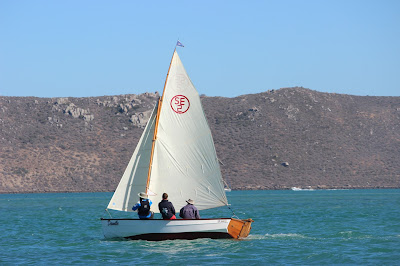The design that I drew broke with all of the traditions of rowing sculls in terms of hull shape. It was very advanced, with shape features not previously seen in rowing shells. Before designing it I told my client that I could draw a boat at least equal to the best but it would be difficult to sell to the traditional rowing community because it would be so very different.
The boats were very fast but, before they could be proven in top level competition, Slade Rowing failed under the weight of logistical problems that overwhelmed the company due to limited funding.
 |
| Vision Lightweight Single scull as built by Slade Rowing. |
An amateur-built pre-preg carbon/epoxy/Nomex boat? No. They have built their boat from strip timber, with a layer of glass on the outside. The first boat was a learning experience and the lessons learned in that first build will be applied to the second build, modifying some details and techniques to improve the result in all respects.
Peter Bowman initiated the project. He was researching rowing shells on-line for a self-build and came across my Vision Single web page. He appreciated that this 17-year old design has advanced features, some of which are now appearing on boats built by the big-name builders. He asked me if it can be built from wood. I had construction drawings available but they were detailed more for recreational rowing than racing in a highly competitive fleet.
Peter teamed up with a friend from the rowing club, Owen Redhead, a tech science teacher. With Owen's expertise, the two felt capable of building the Vision Lightweight Single in strip plank using the low density hardwood paulownia. At 280kg/m^3, straight-grained, easily-worked and gluing well, paulownia is a good choice for boatbuilding when light weight is a requirement.
 |
| Vision Lightweight Single paulownia hull with deck and cockpit being fitted. Alongside is the frame over which the hull skin was constructed. |
 |
| The new wooden boat, ready for launch. |
 |
| Vision Single being rowed by Rohan Hislop. |
This design is not on our pricelist. Email me if you would like to discuss buying plans for it. To see our full range of designs go to our main website or our mobile website.



























